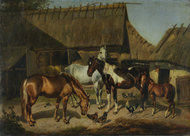Events / Exhibitions
26.04.2017 - 27.05.2017
The Revival of the Armenian Cathedral of Lviv
One of Europe's greatest and most impressive Armenian colonies was established in the 13th-14th centuries in Lviv. It has long been the spiritual and administrative center of Armenians in Poland.
The exhibition is organized with the support of the Embassy of Poland in Armenia and the National Gallery of Armenia.
One of Europe’s largest and most impressive Armenian colonies was established in Lviv in the 13th-14th centuries. It has long been the spiritual and administrative center of Polish-Armenian people. In 1363 the cathedral of the Assumption of Mary was founded in the place of the wooden church built in 1183 with the financial support of Armenian merchants of the large Armenian district.
The cathedral is a vaulted basilica with a cruciform plan and outwardly decorated arches with frescoes inside it. The cathedral has much common with churches of Ani. According to the researchers it was built by Armenian constructors directed by master Doring.
The cathedral of the Assumption of Mary is one of Lviv’s oldest buildings and has been included into UNESCO’s World Heritage list. Later it was extended, as new buildings appeared around, including tower-belfry, the nunnery, the school, the two-storied dwelling of the bishop and congregation members, the printing-house, the cemetery and others.
From the 17th century to the first half of the 20th century the monastery was the residence of Lviv Diocese of Armenian Catholic Church.
In the soviet years after the liquidation of the diocese the depositories of Lviv museums were placed in the cathedral. In 2001 the latter was returned to the Armenian community and Armenian Apostolic Church.
The Cathedral of the Assumption of Mary reflects the whole life period of Armenian colony settled in Poland in the 11th-12th centuries. It became the new and unique image obtained in the result of close cultural and spiritual relations with Eastern European countries.
The Armenian cathedral of Lviv was last reconstructed and illustrated in the beginning of the 20th century by the leader of the diocese, Archbishop Józef Teofil Teodorowicz (1864-1938). Famous Polish artists of the time also took part in it. The new project was implemented by the representatives of the Kraków modernism; architect and designer Franciszek Mączyński (1874-1947) and the professor of the Kraków Academy of Fine Arts Józef Mehoffer (1869-1946). Jan Henryk de Rosen (1891-1982) was the painter of frescoes, mosaic and stained glass windows. His religious and monumental works decorated public buildings and churches of various faiths of Poland and the USA. Frescoes by J.H. de Rosen are of exclusive artistic significance. Besides the traditional scenes they also depict the artist’s unique creative ideas (“The Funeral of Saint Odilo”, “the Glorification of Saint John the Baptist”, “Saint Giles Defending the Hind” and others).
The icon of the Holy Virgin Mary was placed on the High altar table thus re-establishing the Armenian spirit of the cathedral’s design. Thematic frescoes are bordered with ornamental motifs spread in Armenian medieval miniature. Colourful altar pendants, pictures of birds and animals by the sides of the stained glass windows are synthesized with new architectural solutions, frescoes and mosaic of the expanded part. Past and present are harmoniously united in the cathedral.
With the financial support of Polish authorities the Alumni Association of the Kraków Heritage Academy carried out the restoration and conservation work of the cathedral’s interior design in 2008-2015.
The team involved in the work included distinguished specialists like Pawel Baranowski, Joanna Czernichowska, Inna Dmytruk-Sorokhtej, Ruslana Herman, Agnieszka Kalbaczyk and others. Thanks to the artists’ professional approach and modern ways of restoration the Armenian cathedral saved from destruction with its unique decoration became the live evidence of the centuries-old friendship of Polish, Ukrainian and Armenian people based on Christian values.
A number of exhibitions dedicated to the Armenian cathedral and its creators were organized in Lviv and in different cities of Poland.
With the support of Polish government the exhibition representing the cathedral will also be organized in Armenia.
The exhibition will be open till May 27, 2017.
